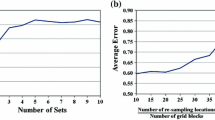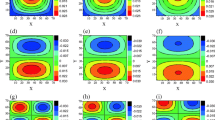Abstract
The Ensemble Kalman Filter (EnKF) often fails to reproduce realistic facies distribution and proportion corresponding to the prior spatial distribution. In this paper, a new step is proposed for inclusion in the history matching of multiple facies reservoir models using EnKF. The new step consists of constructing a facies probability map and application of probability field (P-Field) simulation to re-sample a new ensemble. After certain number of assimilation steps in EnKF, the updated ensemble members are used to propose a probability map for facies distribution. P-Field simulation is performed subsequently using the facies probability map to generate a new ensemble, which honors the static geologic data and is more consistent with the early production data. After the re-sampling step, the forecast model is applied to the new ensemble from the beginning. EnKF is again applied on the ensemble members to assimilate the remaining production history. Two case studies with different facies distribution and well configurations were conducted. Initial ensemble was created using known facies classification at the well locations and populating binary facies data throughout the reservoir using prior information of spatial facies distribution and facies proportions. The qualities of the history-matched models were assessed by comparing the spatial facies distribution and proportions of the updated ensemble, in addition to the root mean square error of the predicted data mismatch. Implementation of EnKF together with re-sampling of the new realizations using probability maps demonstrates reasonable improvement in the history matching and uncertainty assessment of multiple facies reservoir models.

















Similar content being viewed by others
References
Aanonsen, S. I., Nævdal, G., Oliver, D. S., Reynolds, A. C., & Valles, B. (2009). The Ensemble Kalman Filter in reservoir engineering: A review. SPE Journal, 14(3), 393–412.
Agbalaka, C., & Oliver, D. S. (2008). Application of the EnKF and localization to automatic history matching of facies distribution and production data. Mathematical Geosciences, 40(4), 353–374.
Deutsch, C. V., & Journel, A. G. (1997). GSLIB: Geostatistical software library and user’s guide (2nd ed.). New York: Oxford University Press.
Dovera, L., & Della Rossa, E. (2010). Multimodal Ensemble Kalman filtering using Gaussian mixture models. Computational Geosciences, 15(2), 307–323.
ECLIPSE 100 (Black Oil). (2011). Reference manual and technical description. Houston: Schlumberger GeoQuest.
Emerick, A. A., & Reynolds, A. C. (2012). Combining the Ensemble Kalman Filter with Markov Chain Monte Carlo for improved history matching and uncertainty characterization. SPE Journal, 17(2), 418–440.
Evensen, G. (2007). Data assimilation: The Ensemble Kalman Filter. Berlin: Springer.
Froidevaux, R. (1993). Probability field simulation. In A. Soares (Ed.), Geostatistics Troia ’92 (Vol. 2, pp. 73–84). Dordrecht: Kluwer.
Jafarpour, B., & McLaughlin, D. B. (2008). History matching with an ensemble Kalman filter and discrete cosine parameterization. Computational Geosciences, 12(2), 227–244.
Jafarpour, B., & Tarrahi, M. (2011). Assessing the performance of the Ensemble Kalman Filter for subsurface flow data integration under variogram uncertainty. Water Resources Research, 47, W05537. doi:10.1029/2010WR009090.
Jain, A. K. (1988). Fundamentals of digital image processing. Englewood Cliffs, NJ: Prentice-Hall.
Li, L., Zhou, H., Hendricks Franssen, H. J., & Gómez-Hernández, J. J. (2012). Groundwater flow inverse modeling in non-MultiGaussian media: Performance assessment of the normal-score Ensemble Kalman Filter. Hydrology and Earth System Sciences, 16(2), 573–590.
Liu, N., & Oliver, D. S. (2005). Ensemble Kalman Filter for automatic history matching of geologic facies. Journal of Petroleum Science and Engineering, 47(3–4), 147–161.
Lorentzen, R. J., Fjelde, K. K., Froyen, J., Lage, A. C., Naevdal, G., & Vefring, E. H. (2001). Underbalanced and low-head drilling operations: Real time interpretation of measured data and operational support. Paper SPE 71384 presented at the SPE Annual Technical Conference and Exhibition, New Orleans, September 30–October 3.
Modis, K., & Sideri, D. (2013). Geostatistical simulation of hydrofacies heterogeneity of the west thessaly aquifer systems in Greece. Natural Resources Research, 22(2), 123–138.
Moreno, D., & Aanonsen, S. I. (2011). Continuous facies updating using the Ensemble Kalman Filter and the level set method. Mathematical Geosciences, 43(8), 951–970.
Nejadi, S., Trivedi, J., & Leung, J. (2012). Estimation of geological facies boundaries using categorical indicators with P-Field simulation and Ensemble Kalman Filter. Paper SPE 153645 presented at the SPE Latin America and Caribbean Petroleum Engineering Conference, Mexico City, Mexico, 16–18 April.
Nejadi, S., Trivedi, J., & Leung, J. (2012). Ensemble Kalman Filter predictor bias correction method for non-Gaussian geological facies detection. IFAC Conference on Automatic Control in Offshore Oil and Gas Production (ACOOG 2012), Norwegian University of Science and Technology, Trondheim, Norway, 31 May–1 June.
Pyrcz, M. J., & Deutsch, C. V. (2001). Two artifacts of probability field simulation. Mathematical Geology, 33(7), 775–799.
Rao, K. R., & Yip, P. (1990). Discrete cosine transform: Algorithms, advantages, applications. Boston: Academic Press.
Remy, N., Boucher, A., & Wu, J. (2009). Applied geostatistics with SGeMS: A user’s guide. Cambridge: Cambridge University Press.
Srivastava, R. M. (1992). Reservoir characterization with probability field simulation. SPE Formation Evaluation, 7, 927–937.
Teng, Y., & Koike, K. (2007). Three-dimensional imaging of a geothermal system using temperature and geological models derived from a well-log dataset. Geothermics, 36(6), 518–538.
Yamamoto, J. K., Mao, X. M., Koike, K., Crosta, A. P., Landim, P. M. B., Hu, H. Z., et al. (2012). Mapping an uncertainty zone between interpolated types of a categorical variable. Computers & Geosciences, 40, 146–152.
Zafari, M., & Reynolds, A. C. (2007). Assessing the uncertainty in reservoir description and performance predictions with the Ensemble Kalman Filter. SPE Journal, 12(3), 382–391.
Acknowledgments
The authors wish to acknowledge the financial support from NSERC Discovery Grant and the University of Alberta for this research. The ECLIPSE black-oil reservoir simulator was provided by Schlumberger.
Author information
Authors and Affiliations
Corresponding author
Rights and permissions
About this article
Cite this article
Nejadi, S., Trivedi, J. & Leung, J.Y. Estimation of Facies Boundaries Using Categorical Indicators with P-Field Simulation and Ensemble Kalman Filter (EnKF). Nat Resour Res 24, 121–138 (2015). https://doi.org/10.1007/s11053-014-9233-0
Received:
Accepted:
Published:
Issue Date:
DOI: https://doi.org/10.1007/s11053-014-9233-0




